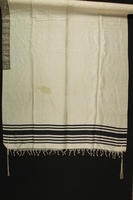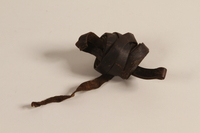Overview
- Brief Narrative
- Miniature Torah preserved by Johanna Baruch Boas while living in hiding in Brussels, Belgium. The Torah belonged to her husband, Bernhard, and was possibly used while traveling. Bernhard died in Berlin in 1932. Johanna carried it with her when she fled Nazi Germany for Brussels in March 1939, with her daughter’s family. The Germans occupied Belgium in May 1940 and enacted punitive anti-Jewish legislation. Soon they were deporting Jews to concentration camps. Johanna buried the yarmulke and other religious items to keep them safe during the occupation. Johanna survived with the help of her non-Jewish landlady who hid her in her attic. In December 1944, she was reunited with her 11 year old niece, Beatrice Westheimer, who had fled Germany with her. She had lived in hiding in a small village, but her parents and an uncle had been deported and killed at Auschwitz. Johanna and Beatrice immigrated to the United States in 1946.
- Title
- Miniature Torah scroll
- Date
-
use:
1932
found: 1945
- Credit Line
- United States Holocaust Memorial Museum Collection, Gift of Beatrice Muchman
Physical Details
- Classification
-
Jewish Art and Symbolism
- Category
-
Jewish ceremonial objects
- Object Type
-
Torah scrolls (lcsh)
- Physical Description
- Miniature paper Torah scroll with printed Hebrew text wound on a wooden dowel with red plastic handles. Blue discs with Asian characters surround the scroll. The outer wrapping is white cloth with a yellow band on the edges. The cloth has a gold colored printed design of a crown flanked by Hebrew text; beneath are tablets flanked by 2 lions, within a scrollwork design. Beneath this is a 6-pointed Star of David and the word Genesis written in English to the left of the star and written in Hebrew to the right. The scroll is a long piece of paper made up of sections with printed blocks of Hebrew text.
- Dimensions
- Height: 4.500 inches (11.43 cm) | Width: 1.000 inches (2.54 cm)
overall: Height: 135.380 inches (343.865 cm) | Width: 4.620 inches (11.735 cm) - Materials
- overall : paper, wood, plastic, cloth, ink, adhesive
Rights & Restrictions
- Conditions on Access
- No restrictions on access
- Conditions on Use
- No restrictions on use
Keywords & Subjects
- Topical Term
- Hidden children (Holocaust)--Belgium. Holocaust, Jewish (1939-1945)--Belgium--Personal narratives. Holocaust, Jewish (1939-1945)--Germany--Personal narratives. Jewish children in the Holocaust--Belgium. Jewish families--Belgium. Jewish refugees--Belgium. Righteous Gentiles in the Holocaust--Belgium. World War, 1939-1945--Jews--Rescue--Belgium. World War, 1939-1945--Refugees--Belgium.
Administrative Notes
- Legal Status
- Permanent Collection
- Provenance
- The miniature Torah was donated to the United States Holocaust Memorial Museum in 2007 by Beatrice Muchman, the granddaughter of Johanna Baruch Boas.
- Record last modified:
- 2022-07-28 17:51:46
- This page:
- https://collections.ushmm.org/search/catalog/irn35054
Download & Licensing
In-Person Research
- By Appointment
- Request 21 Days in Advance of Visit
- Plan a Research Visit
- Request to See This Object
Contact Us
Also in This Collection

Kippah buried for safekeeping while the owner lived in hiding
Object
Yarmulke, a skullcap worn by observant Jewish males, buried for safekeeping with other religious items by Johanna Baruch Boas while she lived in hiding in Brussels, Belgium, from 1942-1944. It originally belonged to her husband, Bernhard, who died in Berlin, Germany, in 1932. She brought it with her when she fled Nazi Germany for Brussels in March 1939 with her daughter’s family. Germany occupied Belgium in May 1940 and soon there were frequent deportations of Jews to concentration camps. Johanna had a non-Jewish landlady who hid her in her attic. In December 1944, a few months after the liberation of Belgium, Johanna was reunited with her 11 year old niece, Beatrice Westheimer, who had been placed in hiding in a small country village. Her mother, Johanna's daughter, and her father, as well as a paternal uncle, had been killed at Auschwitz. Johanna and Beatrice joined family members in the United States in 1946.

Black velvet embroidered tefillin bag buried for safekeeping while owner in hiding
Object
Black velvet pouch used to hold his tefillin, prayer boxes worn by Jewish males during morning prayer services, buried for safekeeping with other religious items by Johanna Baruch Boas while she lived in hiding in Brussels, Belgium, from 1942-1944. It originally belonged to her husband, Bernhard, who died in Berlin, Germany, in 1932. She brought it with her when she fled Nazi Germany for Brussels in March 1939 with her daughter’s family. Germany occupied Belgium in May 1940 and soon there were frequent deportations of Jews to concentration camps. Johanna had a non-Jewish landlady who hid her in her attic. In December 1944, a few months after the liberation of Belgium, Johanna was reunited with her 11 year old niece, Beatrice Westheimer, who had been placed in hiding in a small country village. Her mother, Johanna's daughter, and her father, as well as a paternal uncle, had been killed at Auschwitz. Johanna and Beatrice joined family members in the United States in 1946.

Green velvet monogrammed tallit pouch buried for safekeeping while owner in hiding
Object
Velvet tallit pouch buried for safekeeping with other religious items by Johanna Baruch Boas while she lived in hiding in Brussels, Belgium, from 1942-1944. A tallit is a prayer shawl worn by Jewish males for prayer services, It originally belonged to her husband, Bernhard, who died in Berlin, Germany, in 1932. She brought it with her when she fled Nazi Germany for Brussels in March 1939 with her daughter’s family. Germany occupied Belgium in May 1940 and soon there were frequent deportations of Jews to concentration camps. Johanna had a non-Jewish landlady who hid her in her attic. In December 1944, a few months after the liberation of Belgium, Johanna was reunited with her 11 year old niece, Beatrice Westheimer, who had been placed in hiding in a small country village. Her mother, Johanna's daughter, and her father, as well as a paternal uncle, had been killed at Auschwitz. Johanna and Beatrice joined family members in the United States in 1946.

Tallit with dark blue stripes on each end buried for safekeeping
Object
Tallit or prayer shawl buried for safekeeping by Johanna Baruch Boas while she lived in hiding in Brussels, Belgium, from 1942-1944. The tallit was worn by her husband, Bernhard, during religious services. Bernhard died in Berlin, Germany, in 1932. She brought it with her when she fled Nazi Germany for Brussels in March 1939 with her daughter’s family. Germany occupied Belgium in May 1940 and soon there were frequent deportations of Jews to concentration camps. Johanna had a non-Jewish landlady who hid her in her attic. In December 1944, a few months after the liberation of Belgium, Johanna was reunited with her 11 year old niece, Beatrice Westheimer, who had been placed in hiding in a small country village. Her mother, Johanna's daughter, and her father, as well as a paternal uncle, had been killed at Auschwitz. Johanna and Beatrice joined family members in the United States in 1946.

Set of tefillin buried for safekeeping while the owner lived in hiding
Object
Tefillin pair buried for safekeeping by Johanna Baruch Boas while she lived in hiding in Brussels, Belgium, from 1942-1944. They were used by her husband Bernhard who died in Berlin, Germany, in 1932. Tefillin are small boxes that contain prayers that are attached to leather straps and worn by Orthodox Jewish males during morning prayers. Johanna brought the tefillin with her when she fled Nazi Germany for Brussels in March 1939 with her daughter’s family. Germany occupied Belgium in May 1940 and by 1942 there were frequent deportations of Jews to concentration camps. Johanna had a non-Jewish landlady who hid her in her attic. In December 1944, a few months after the liberation of Belgium, Johanna was reunited with her 11 year old niece, Beatrice Westheimer, who had been placed in hiding in a small country village. Her mother, Johanna's daughter, and her father, as well as a paternal uncle, had been killed at Auschwitz. Johanna and Beatrice joined family members in the United States in 1946.
Book
Object
Children's book, Der Struwwelpeter, read by 11year old Beatrice (Trixie) Westheimer when she was a hidden child in German occupied Belgium. It was originally written in 1945 and is a series of illustrated rhymes that tell fables about the unfortunate consequences that befall ill-behaved children. Trixie and her family fled Germany in 1939, joining relatives in Belgium. In May 1940, Germany occupied Belgium and in July 1942, the family went into hiding. Trixie and her cousin Henri were hidden on a farm and baptized as Catholics. In February1943, her parents Julius and Meta were deported; her father was shot during an escape attempt and her mother was killed in Auschwitz. In December 1944, Trixie and Henri returned to liberated Brussels. Trixie and her grandmother Johanna Boas emigrated to the United States in 1946.



